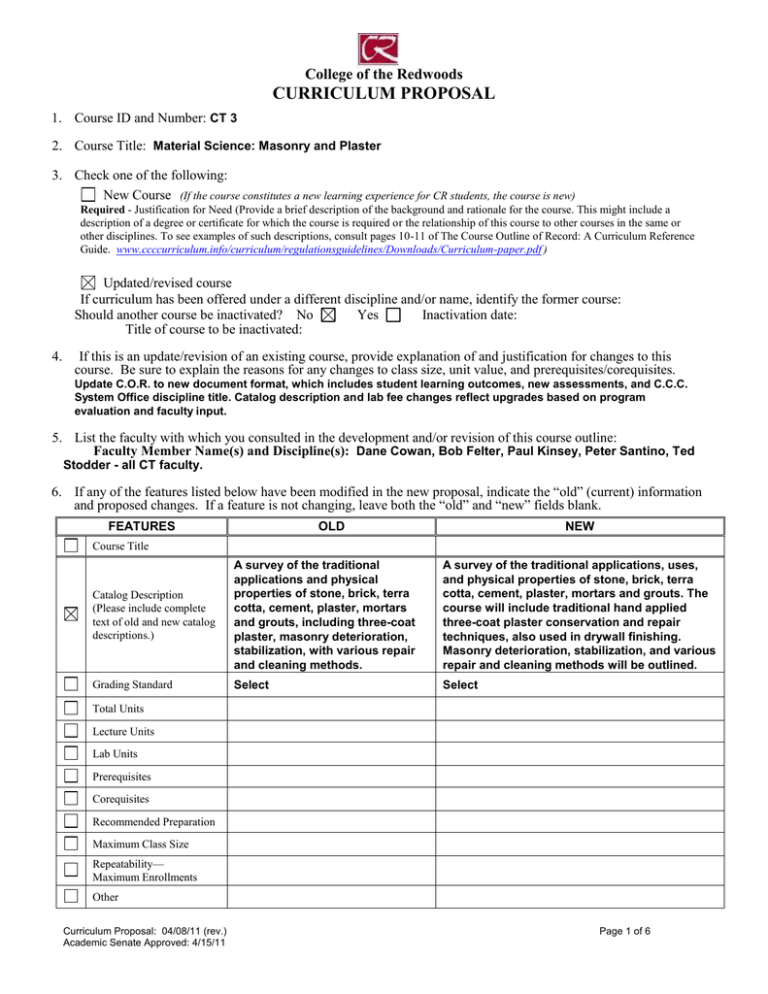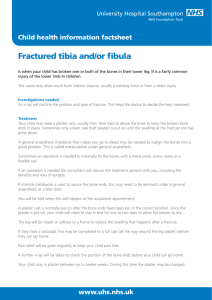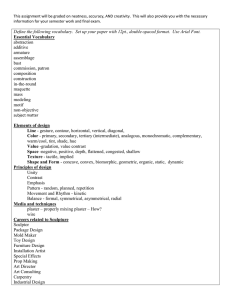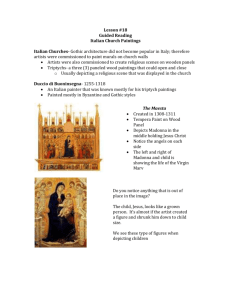CURRICULUM PROPOSAL College of the Redwoods 1. Course ID and Number:
advertisement

College of the Redwoods CURRICULUM PROPOSAL 1. Course ID and Number: CT 3 2. Course Title: Material Science: Masonry and Plaster 3. Check one of the following: New Course (If the course constitutes a new learning experience for CR students, the course is new) Required - Justification for Need (Provide a brief description of the background and rationale for the course. This might include a description of a degree or certificate for which the course is required or the relationship of this course to other courses in the same or other disciplines. To see examples of such descriptions, consult pages 10-11 of The Course Outline of Record: A Curriculum Reference Guide. www.ccccurriculum.info/curriculum/regulationsguidelines/Downloads/Curriculum-paper.pdf ) Updated/revised course If curriculum has been offered under a different discipline and/or name, identify the former course: Should another course be inactivated? No Yes Inactivation date: Title of course to be inactivated: 4. If this is an update/revision of an existing course, provide explanation of and justification for changes to this course. Be sure to explain the reasons for any changes to class size, unit value, and prerequisites/corequisites. Update C.O.R. to new document format, which includes student learning outcomes, new assessments, and C.C.C. System Office discipline title. Catalog description and lab fee changes reflect upgrades based on program evaluation and faculty input. 5. List the faculty with which you consulted in the development and/or revision of this course outline: Faculty Member Name(s) and Discipline(s): Dane Cowan, Bob Felter, Paul Kinsey, Peter Santino, Ted Stodder - all CT faculty. 6. If any of the features listed below have been modified in the new proposal, indicate the “old” (current) information and proposed changes. If a feature is not changing, leave both the “old” and “new” fields blank. FEATURES OLD NEW Course Title Catalog Description (Please include complete text of old and new catalog descriptions.) A survey of the traditional applications and physical properties of stone, brick, terra cotta, cement, plaster, mortars and grouts, including three-coat plaster, masonry deterioration, stabilization, with various repair and cleaning methods. A survey of the traditional applications, uses, and physical properties of stone, brick, terra cotta, cement, plaster, mortars and grouts. The course will include traditional hand applied three-coat plaster conservation and repair techniques, also used in drywall finishing. Masonry deterioration, stabilization, and various repair and cleaning methods will be outlined. Grading Standard Select Select Total Units Lecture Units Lab Units Prerequisites Corequisites Recommended Preparation Maximum Class Size Repeatability— Maximum Enrollments Other Curriculum Proposal: 04/08/11 (rev.) Academic Senate Approved: 4/15/11 Page 1 of 6 College of the Redwoods COURSE OUTLINE 1. DATE: 10/18/11 2. DIVISION: Business and Applied Technology 3. COURSE ID AND NUMBER: CT 3 4. COURSE TITLE (appears in catalog and schedule of classes): Material Science: Masonry and Plaster 5. SHORT TITLE (appears on student transcripts; limited to 30 characters, including spaces): Materials: Masonry/Plaster 6. LOCAL ID (TOPS): 0952.60 (Taxonomy of Program codes http://www.cccco.edu/Portals/4/TopTax6_rev0909.pdf) 7. NATIONAL ID (CIP): 46.0101 (Classification of Instructional Program codes can be found in Appendix B of the TOPS code book http://www.cccco.edu/Portals/4/AA/CrosswalkTOP6to2010CIP.pdf) 8. Discipline(s): Select from CCC System Office Minimum Qualifications for Faculty http://www.cccco.edu/Portals/4/AA/Minimum%20Qualifications%20Handbook%20for%202010-2012.pdf Course may fit more than one discipline; identify all that apply: Construction Technology 9. FIRST TERM NEW OR REVISED COURSE MAY BE OFFERED: Fall 2012 10. TOTAL UNITS: 2 TOTAL HOURS: 54 [Lecture Units: 1.5 Lab Units: 0.5] [Lecture Hours: 27 Lab Hours: 27] (1 unit lecture=18 hours; 1 unit lab=54 hours) 11. MAXIMUM CLASS SIZE: 20 12. WILL THIS COURSE HAVE AN INSTRUCTIONAL MATERIALS FEE? No Fee: $20 Yes (If “yes,” attach a completed “Instructional Materials Fee Request Form”—form available in Public Folders>Curriculum>Forms) GRADING STANDARD Letter Grade Only Pass/No Pass Only Is this course a repeatable lab course: No Yes Grade-Pass/No Pass Option If yes, how many total enrollments? Is this course to be offered as part of the Honors Program? No Yes If yes, explain how honors sections of the course are different from standard sections. CATALOG DESCRIPTION -- The catalog description should clearly describe for students the scope of the course, its level, and what kinds of student goals the course is designed to fulfill. The catalog description should begin with a sentence fragment. A survey of the traditional applications, uses, and physical properties of stone, brick, terra cotta, cement, plaster, mortars and grouts. The course will include traditional hand applied three-coat plaster conservation and repair techniques, also used in drywall finishing. Masonry deterioration, stabilization, and various repair and cleaning methods will be outlined. Special notes or advisories (e.g. field trips required, prior admission to special program required, etc.): Note: Field trips are a component of this course. Transportation is not provided by the college. PREREQUISITE COURSE(S) No Yes Course(s): Rationale for Prerequisite: Describe representative skills without which the student would be highly unlikely to succeed . COREQUISITE COURSE(S) No Yes Course(s): Rationale for Corequisite: Curriculum Proposal: 04/08/11 (rev.) Academic Senate Approved: 4/15/11 Page 2 of 6 RECOMMENDED PREPARATION No Yes Course(s): Rationale for Recommended Preparation: COURSE LEARNING OUTCOMES –This section answers the question “what will students be able to do as a result of taking this course?” State some of the objectives in terms of specific, measurable student actions (e.g. discuss, identify, describe, analyze, construct, compare, compose, display, report, select, etc.). For a more complete list of outcome verbs please see Public Folders>Curriculum>Help Folder>SLO Language Chart. Each outcome should be numbered. 1. Compare conservation and restoration strategies of masonry and plaster conservation. 2. Demonstrate proper technique and application of plaster to repair historic wood lath/plaster surfaces. 3. Describe the various uses of masonry and plaster found in the historic built environment. 4. Conserve and/or restore selected masonry elements used in historic built environments. 5. Compare the physical properties of materials such as stone, brick, and terra cotta. COURSE CONTENT–This section describes what the course is “about”-i.e. what it covers and what knowledge students will acquire Concepts: What terms and ideas will students need to understand and be conversant with as they demonstrate course outcomes? Each concept should be numbered. 1. Masonry units and traditional plaster used in historic buildings. 2. Lime putty plaster and mortar. 3. Animal hair binders used in traditional plaster. 4. Repair/recycle/reuse. 5. Building sustainablity through conservation strategies of existing materials. Issues: What primary tensions or problems inherent in the subject matter of the course will students engage? Each issue should be numbered. 1. Teamwork. 2. Gender neutral jobsite environment. 3. Plaster and mortar mixing to proper consistency with water. 4. Hand/eye coordination of steel troweling plaster wall/ceiling surfaces. Themes: What motifs, if any, are threaded throughout the course? Each theme should be numbered. 1. Building conservation and sustainability. 2. Recycle/reuse. 3. Natural vs. manmade materials. Skills: What abilities must students have in order to demonstrate course outcomes? (E.g. write clearly, use a scientific calculator, read college-level texts, create a field notebook, safely use power tools, etc). Each skill should be numbered. 1. 2. 3. 4. 5. Create a field notebook, including lab reports. Mix plaster and mortar with water to proper consistency. Safely work in historic building environment, using personal protective equipment properly. Discuss the differences between ingredients used in historic and modern plaster. Discuss the importance of analyzing mortar ingredients when re-pointing existing brick units. REPRESENTATIVE LEARNING ACTIVITIES –This section provides examples of things students may do to engage the course content (e.g., listening to lectures, participating in discussions and/or group activities, attending a field trip). These activities should relate directly to the Course Learning Outcomes. Each activity should be numbered. 1. 2. 3. 4. 5. Listening to lectures. Participating in field school laboratory assignments in teams. Attending a field trip. Learning to mix plaster and mortar while keeping tools and work area clean. Completing written homework and research assignments. ASSESSMENT TASKS –This section describes assessments instructors may use to allow students opportunities to provide evidence of achieving the Course Learning Outcomes. Each assessment should be numbered. Representative assessment tasks (These are examples of assessments instructors could use): 1. Student use of standard health and safety practices at existing building assessment projects. 2. Individual project evaluation with instructor. Curriculum Proposal: 04/08/11 (rev.) Academic Senate Approved: 4/15/11 Page 3 of 6 3. Participate in group discussion and critiques. Required assessments for all sections (These are assessments that are required of all instructors of all sections at all campuses/sites. Not all courses will have required assessments. Do not list here assessments that are listed as representative assessments above.): 1. Completed project review. 2. Written lab assessment reports. 3. Written tests and exams. EXAMPLES OF APPROPRIATE TEXTS OR OTHER READINGS –This section lists example texts, not required texts. Author, Title, and Date Fields are required Author Van Den Branden/Hartsell Author Title Date Author Title Date Author Title Date Title Plastering Skills Date current edition Other Appropriate Readings: COURSE TYPES 1. Is the course part of a Chancellor’s Office approved CR Associate Degree? No Yes If yes, specify all program codes that apply. (Codes can be found in Outlook/Public Folders/All Public Folders/ Curriculum/Degree and Certificate Programs/choose appropriate catalog year): Required course for degree(s) Restricted elective for degree (s) CT.AS.HPRT Restricted electives are courses specifically listed (i.e. by name and number) as optional courses from which students may choose to complete a specific number of units required for an approved degree. 2. Is the course part of a Chancellor’s Office approved CR Certificate of Achievement? No Yes If yes, specify all program codes that apply. ( Codes can be found in Outlook/Public Folders/All Public Folders/ Curriculum/Degree and Certificate Programs/choose appropriate catalog year): Required course for certificate(s) Restricted elective for certificate(s) CT.CA.HPRT Restricted electives are courses specifically listed (i.e. by name and number) as optional courses from which students may choose to complete a specific number of units required for an approved certificate. 3. Is the course Stand Alone? No Yes (If “No” is checked for BOTH #1 & #2 above, the course is stand alone) 4. Basic Skills: NBS Not Basic Skills 5. Work Experience: NWE Not Coop Work Experience 6. Course eligible Career Technical Education funding (applies to vocational and tech-prep courses only): yes 7. Purpose: I Occupational Ed 8. Accounting Method: D Daily Census 9. Disability Status: N Not a Special Class no CURRENT TRANSFERABILITY STATUS (Check at least one box below): This course is currently transferable to Neither CSU nor UC CSU as general elective credit CSU as a specific course equivalent (see below) If the course transfers as a specific course equivalent, give course number(s)/ title(s) of one or more currently-active, equivalent lower division courses from CSU. 1. Course , Campus Curriculum Proposal: 04/08/11 (rev.) Academic Senate Approved: 4/15/11 2. Course , Campus Page 4 of 6 UC as general elective credit UC as specific course equivalent If the course transfers as a specific course equivalent, give course number(s)/ title(s) of one or more currently-active, equivalent lower division courses from UC. 1. Course , Campus 2. Course , Campus PROPOSED CSU TRANSFERABILITY (Check at least one of the boxes below): No proposal Remove as General Education Propose as General Elective Credit Propose as a Specific Course Equivalent (see below) If specific course equivalent credit is proposed, give course number(s)/ title(s) of one or more currently-active, equivalent lower division courses from CSU. 1. Course , Campus 2. Course , Campus PROPOSED UC TRANSFERABILITY (Check one of the boxes below): No proposal Remove as General Education Propose as General Elective Credit OR Specific Course Equivalent (fill in information below) If “General Elective Credit OR Specific Course Equivalent” box above is checked, give course number(s)/ title(s) of one or more currently-active, equivalent lower division courses from UC. 1. Course , Campus 2. Course , Campus CURRENTLY APPROVED GENERAL EDUCATION Check at least one box below): Not currently approved CR CR GE Category: CSU CSU GE Category: IGETC IGETC Category: PROPOSED CR GENERAL EDUCATION (Check at least one box below): No proposal ____ Approved as CR GE by Curriculum Committee:_____ _ Remove as General Education (DATE) Review to maintain CR GE Status ____ Not approved. New GE Proposal CR GE Outcomes GE learning outcomes in Effective Communication, Critical Thinking, Global Awareness must be addressed in all general education courses. Effective Communications: Explain how the proposed GE course fulfills at least one of the CR GE outcomes in this category. Critical Thinking: Explain how the proposed GE course fulfills at least one of the CR GE outcomes in this category. Global Awareness: Explain how the proposed GE course fulfills at least one of the CR GE outcomes in this category. GE Criteria for Breadth and Generality GE courses should be broad and general in scope. Typically such courses are introductory-- not advanced or specialized—and the content encompasses a broad spectrum of knowledge within a given field of study. Explain how the proposed GE course fulfills GE criteria for breadth and generality. CR GE Area Designation Course Learning Outcomes and Course Content should provide evidence of appropriate GE Area Designation. Additional rationale for GE Area Designation (optional): Curriculum Proposal: 04/08/11 (rev.) Academic Senate Approved: 4/15/11 Page 5 of 6 Natural Science Social Science Humanities Language and Rationality Writing Oral Communications Analytical Thinking PROPOSED CSU GENERAL EDUCATION BREADTH (CSU GE) (Check at least one box below): No proposal A. Communications and Critical Thinking A1 – Oral Communication A2 – Written Communication A3 – Critical Thinking B. Science and Math B1 – Physical Science B2 – Life Science B3 – Laboratory Activity B4 – Mathematics/Quantitative Reasoning C. Arts, Literature, Philosophy, and Foreign Language C1 – Arts (Art, Dance, Music, Theater) C2 – Humanities (Literature, Philosophy, Foreign Language) E. Lifelong Understanding and Self-Development E1 – Lifelong Understanding E2 – Self-Development D. Social, Political, and Economic Institutions D0 – Sociology and Criminology D1 – Anthropology and Archeology D2 – Economics D3 – Ethnic Studies D5 – Geography D6 – History D7 – Interdisciplinary Social or Behavioral Science D8 – Political Science, Government and Legal Institutions D9 – Psychology Rationale for inclusion in this General Education category: Same as above Proposed Intersegmental General Education Transfer Curriculum (IGETC) (Check at least one box below ): No proposal 1A – English Composition 1B – Critical Thinking-English Composition 1C – Oral Communication (CSU requirement only) 2A – Math 3A – Arts 3B – Humanities 4A – Anthropology and Archaeology 4B – Economics 4E – Geography 4F – History 4G – Interdisciplinary, Social & Behavioral Sciences 4H – Political Science, Government & Legal Institutions 4I – Psychology 4J – Sociology & Criminology 5A – Physical Science 5B – Biological Science 6A – Languages Other Than English Rationale for inclusion in this General Education category: Same as above Submitted by: Bill Hole Division Chair/Director: Jeff Cummings Tel. Ext. 4353 Review Date: 10/28/11 Approved by Curriculum Committee: No Academic Senate Approval Date: 12.14.11 CURRICULUM COMMITTEE USE ONLY Yes Date: 12.9.11 Board of Trustees Approval Date: 1.3.12 Curriculum Proposal: 04/08/11 (rev.) Academic Senate Approved: 4/15/11 Date: 10/20/11 Page 6 of 6




![First Aid Training : Bronze [Power Point]](http://s2.studylib.net/store/data/005424634_1-e0b0e5e602f7c1666ebc2e9ff3f4a1b5-300x300.png)
